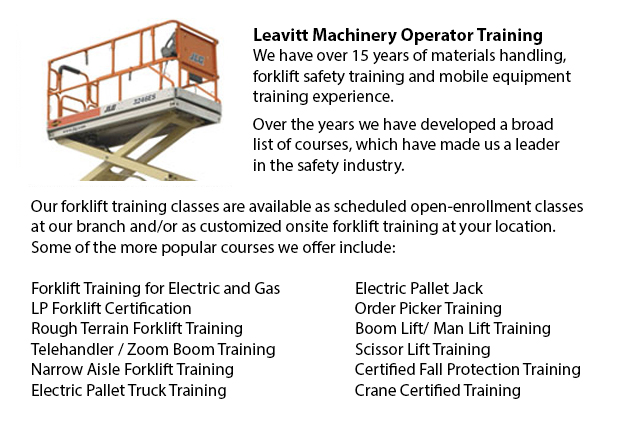
Scissor Lift Certification Ottawa - Numerous worksites and tradespeople like masons, iron workers and welders utilize scissor lift platforms to be able to help them reach elevated work places. The operation of a scissor lift is normally secondary to their trade. Thus, it is essential that all operators of these platforms be well trained and certified. Lift manufacturers, regulators and industry work together in order to ensure that operators are trained in the safe utilization of work platforms.
Work platforms are also called manlifts or AWPs. These machinery are stable and easy to operate, although there is always some risk since they lift individuals to heights. The following are several key safety issues common to AWPs:
In order to protect individuals working around work platforms from accidental discharge of power because of close working proximities to power lines and wires, there is a minimum safe approach distance (also referred to as MSAD). Voltage can arc across the air and cause injury to workers on a work platform if MSAD is not observed.
Caution must be taken when the work platform is lowered to ensure steadiness. The boom must be retracted, moving the load toward the turntable. This would help maintain steadiness if the -platform is lowered.
Regulations do not mandate people working on a scissor lift to tie off. Nevertheless, personnel might be needed to tie off if needed by employer guidelines, job-specific risk assessments or local regulations. The manufacturer-provided anchorage is the only safe anchorage to which lanyard and harness combinations should be attached.
It is vital to observe and not exceed the maximum slope rating. The grade can be measured by laying a straight edge on the slope or by laying a board. Next, a carpenter's level can be placed on the straight edge and raised until the end is level. By measuring the distance to the ground and dividing the rise by the straight edge's length, then multiplying by 100, the per cent slope can be determined.
A standard walk-around check should be performed to determine if the unit is mechanically safe. A location assessment determines if the work place is safe. This is vital especially on changing construction locations because of the chance of obstacles, unimproved surfaces, and contact with power lines. A function test needs to be done. If the unit is utilized safely and properly and correct shutdown procedures are followed, the risks of incident are really reduced.
-
Telehandler Ticket Ottawa
Telehandler Ticket Ottawa - The telehandler or telescopic handler is a commonly utilized equipment in industrial and agricultural applications. This machine is the same in look to a forklift and also functions in a similar manner, though telehandlers... More -
Telehandler License Ottawa
Telehandler License Ottawa - The telehandler or telescopic handler is a frequently used machine in industrial and agricultural applications. This particular equipment is the same in appearance to a forklift and even functions in a similar way, althou... More -
Forklift Training Courses Ottawa
Forklift Training Courses Ottawa - Our forklift operator safety training has been tailored for illiteracy, thus cutting the training time in half. We provide forklift training certification, lift-truck operator driver safety training evaluation, and... More -
Boom Lift Certification Ottawa
Boom Lift Certification Ottawa - Making use of elevated work platforms allow for work and maintenance operations to be carried out at elevated work heights which were otherwise unreachable. Workers using scissor lifts and boom lifts can be educated i... More -
Aerial Platform Training Ottawa
Aerial Platform Training Ottawa - Aerial lifts might be used to accomplish certain different duties done in hard to reach aerial spaces. Many of the tasks associated with this style of lift include performing routine upkeep on structures with high ce... More -
Loader Operator Certification Ottawa
Loader Operator Certification Ottawa - Ways To Acquire A Loader Operator Certification - Loader Operator Certification is normally needed for personnel working within construction, warehouse or industrial setting to ensure the safe operation of forkl... More -
Aerial Lift / Boom Lift / Man Lift / Scissor Lift Training in Ottawa
Lift tables or also referred to as scissor hoists can raise both individuals and goods vertically. They are normally utilized in commercial, industrial and construction environments. Commonly, the use of a scissor lift truck is to lift and lower thin... More -
Skid Steer Loader Training in Ottawa
The engine powered skid-steer loader comprises a small and rigid frame, equipped together with lift arms which can connect to lots of industrial attachments and tools so as to perform a wide variety of labor saving jobs. Usually, skid-steer loaders a... More

Forklift Training Ottawa
Ottawa, Ontario
forklifttrainingottawa.com
Email Us
About Us


